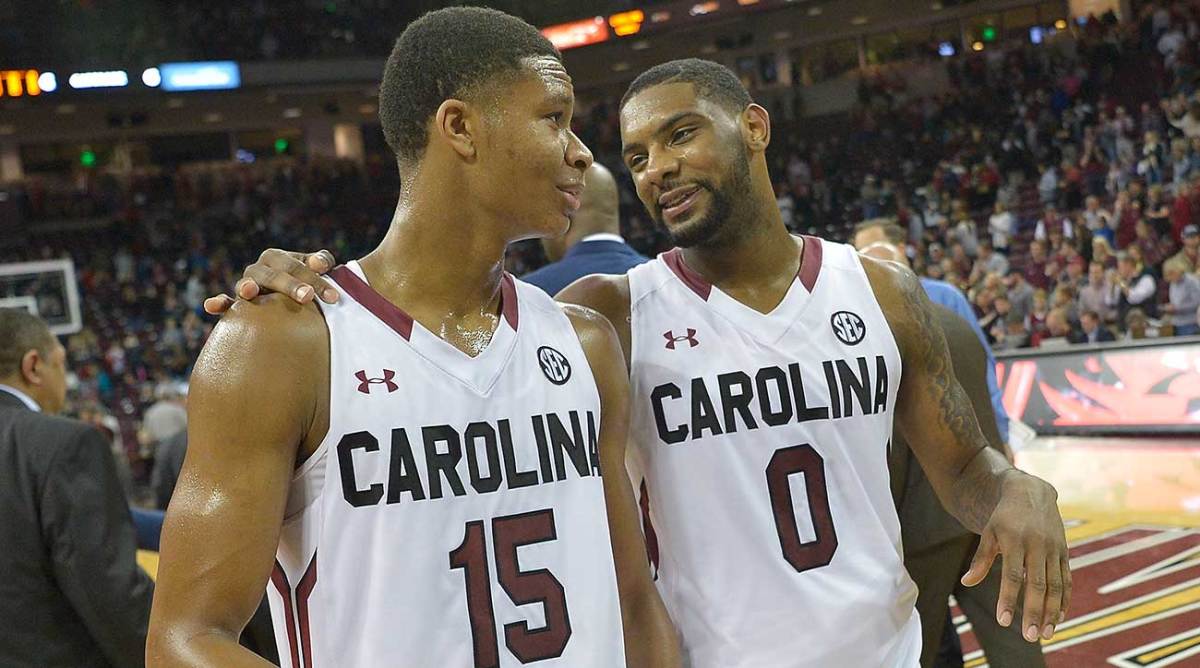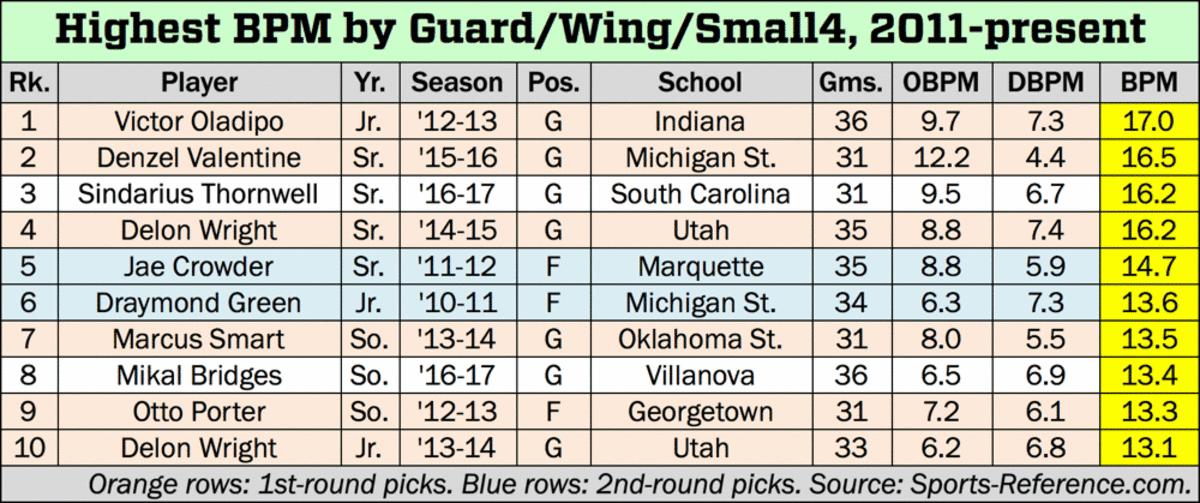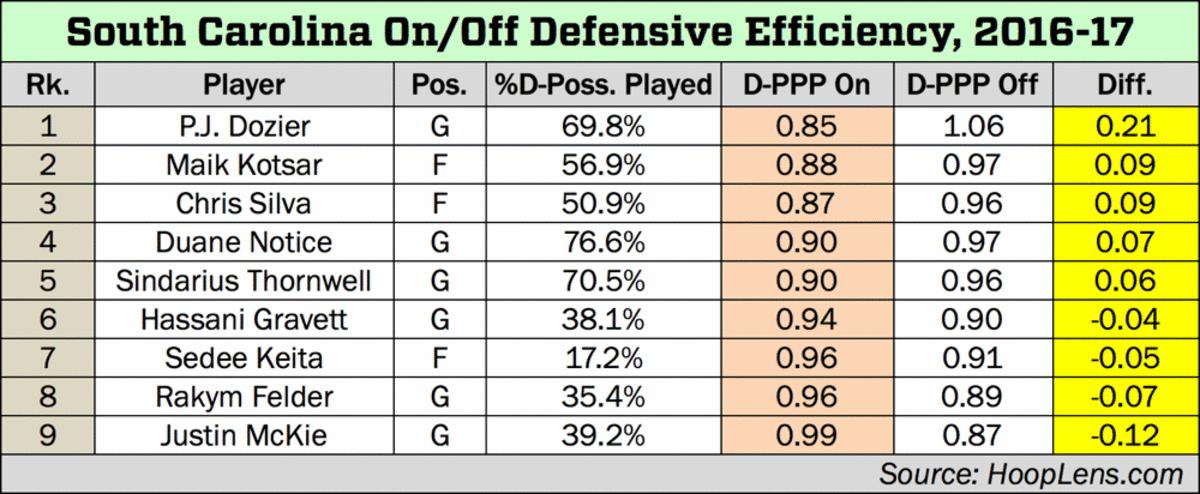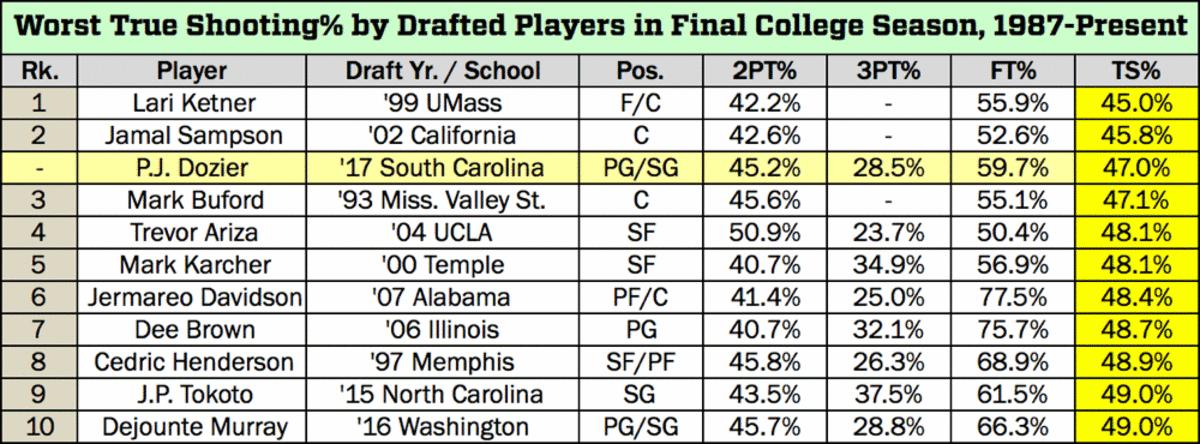NBA Draft: Two Intriguing (But Flawed) Sleepers

What happens in the NCAA tournament—despite it being a small-sample event played in unusual, neutral environments—influences pre-NBA draft discussions. The 2017 tournament fueled the debate over whether UCLA's Lonzo Ball or Kentucky's De'Aaron Fox should be the second point guard off the board; it helped push Gonzaga's Zach Collins into the draft, and elevated his stock toward the lottery; and North Carolina's title run seemingly solidified Justin Jackson as a mid-first round pick.
For Sindarius Thornwell and P.J. Dozier, the stars of the tourney's biggest surprise story, leading No. 7-seeded South Carolina to the Final Four didn't make their draft stock, but it did make NBA teams give deeper consideration as to whether they might be second-round sleepers. Thornwell and Dozier are intriguing but flawed prospects; they're ideal pre-draft study topics, but not locks to be selected in the NBA. Here's why they're worth deliberating, and in the case of Dozier, why he might be too flawed to stick in the league:

• Thornwell is a 6'5" senior guard whom I'd classify as an Extreme Production Prospect. His athleticism is below the elite level for an NBA two-guard or wing, but his productivity in college was so great (Mike Krzyzewski called Thornwell "the best unheralded great player in the United States") that you can't help but wonder if some of it might translate to the league.
There is no perfect, all-encompassing stat for college players, but Sports-Reference.com's Box Plus-Minus, which uses box score stats to estimate how many points per 100 possessions a player is worth above the league average, can at least put Thornwell's traditional-stat productivity in some context. Since 2010-11, when this data began to be available, these are the top 10 BPM college seasons by a major-conference guard, wing or small–ball four:

Thornwell's senior season for the Gamecocks ranks third (+16.2), and this puts him in some interesting company—especially for a guy who's not a lock to be drafted. Of the seven players on this list who left college prior to 2017, three were lottery picks (Victor Oladipo, Otto Porter and Marcus Smart), two were non-lottery first-rounders (Denzel Valentine and Delon Wright) and two were second-round steals (Jae Crowder and Draymond Green). Every versatile prospect's agent seems to be trying to brand their guy as a "Draymond type," but Thornwell is only one whose college production is actually comparable to Green's.
• Thornwell is an Extreme Production Prospect on the advanced-stats front, too. My idea of a player worthy of that designation is one with high efficiency and above-role-player usage (an Offensive Rating of at least 110, and a usage rate of at least 22%), a respectable assist rate (at least 15% of teammates' buckets), and on defense, solid defensive-rebounding percentage (at least 15) and block and steal percentages (at least 3 each). From 2010-11 present, just six players have hit all of those benchmarks:

Thornwell is the highest-usage player (he handled 29.5% of South Carolina's possessions last season) to do so, and once again he's in good company. The others are Kansas's Josh Jackson, a likely top-four pick; Wisconsin's Ethan Happ, a national player of the year candidate in 2017-18; and then Draymond Green, Otto Porter, and Gary Payton II, who went undrafted out of Oregon State but now has a guaranteed deal with the Bucks. Thornwell has his flaws, but it's rare to find a second-round pick available with this kind of statistical resume.
2017 NBA Mock Draft 5.0: All Eyes On Lonzo And The Lakers
• In an era of increasingly position-less basketball, Thornwell is the only prospect in this draft that I've seen play four positions on offense and guard four positions on defense. His primary college spot was as the 2 or 3, but in 2015-16, when the Gamecocks needed help at point guard, Thornwell chipped in—and this season, when they downshifted to small–ball lineups, they deployed him as a small four who could attack opposing bigs off the bounce. On D, he was strong enough to handle college power forwards in the post, and tenacious enough to be a problem for perimeter scorers like Duke's Luke Kennard, who had one of his worst games of the season while being checked by Thornwell in the NCAA tournament. Thornwell also seems to grasp that while he was a star in college, he'll be a role player in the NBA; at the combine he described himself as "a glue guy" and declared that he was "one of the best defenders in the draft." That's not a modest thing to say, but I think he's right.
• Commemorative: Golden State Warriors 2017 Championship Package
As for his drawbacks: Thornwell was arrested in May 2016 for marijuana possession and driving under a suspended license, and he was suspended by South Carolina for six games in December 2016 for an unspecified violation of athletic department policy. Teams have had mixed reactions to his pre-draft interviews. His long-range shot (he made 39.2% of his threes) didn't come around until this season, and he has a slow release with a somewhat flat trajectory; there's understandable skepticism that he can provide the "3" side of the 3-and-D equation. I wouldn't call him a creative offensive player, either—he thrived via brute-force basket attacks, usually in straight-line fashion, some of which won't work in the NBA. I do think some of his game can work, though; I wouldn't use a first-round pick on him, but I'd give him a hard look in the late second, or be first in line to get him on my summer-league roster if he goes undrafted.
• While Thornwell was done with college regardless of what happened in the 2017 NCAA tournament, Dozier used it as a springboard to early entry into the draft as a sophomore. He has a more attractive physical profile than Thornwell does, as Dozier is 6'6" with a 6'11" wingspan, has that long-striding explosiveness that scouts like, and played both point guard and shooting guard for the Gamecocks.
The best argument for Dozier as a second-rounder is that his physical tools plus his defensive instincts will allow him to carve out a role as a perimeter stopper. He's a long, disruptive deflection machine who can also pressure the ball. The only analytic case for him is that he may have been the highest-impact defender on a South Carolina team that ranked third nationally in defensive efficiency and fifth in turnovers-forced percentage.
2017 NBA Draft Sleepers: Six Wings Who Could Stick In The League
According to Hooplens.com's on/off defensive data from 2016-17, it was Dozier's presence in lineups that gave the Gamecocks their best defensive efficiency rating (0.85 points per possession allowed). He also had the best on/off defensive differential—a remarkable +0.21 PPP. Some of that was due to the steep drop-off in quality from Dozier to his backcourt backups, but the big-picture point here is that South Carolina's defense was otherworldly while he was on the floor, and just pedestrian when he rested.

• The argument against Dozier is that he may have a fatal flaw in his offensive game. He's not just a sub-par shooter. Dozier's true shooting percentage of 47.0 (he made 45.2% of his twos, 28.5% of his threes and 59.7% of his free-throws) this season was so bad that I had to really dig to find comparable prospects.
I searched through the final college seasons of every player who was selected in the first two rounds in the three-point era (1987-present), and only found two who played at least 20 games and were worse than Dozier: Lari Ketner, out of UMass in 1999, and Jamal Sampson, out of Cal in '02.

Ketner and Sampson were both centers who didn't shoot threes, which means that Dozier could earn the designation of "least accurate college guard to be selected in the first two rounds in the entire three-point era." That scares me. A defensive specialist can only be so much of an offensive liability in the NBA, and Dozier might be taking it too far.
